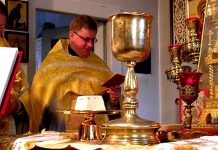From the Catechism of the Catholic Church, Simplified
« prev : next »
A Filial Prayer (2599)
In his human heart Jesus learned to pray from his mother, from the synagogue, and the Jerusalem temple. At 12, Jesus said “I must be in my Father’s house” (Lk 2:49). This reveals a filial prayer which the Father wants from his children.
Prayer at Three Decisive Moments (2600)
Before his three decisive moments (Baptism, Transfiguration, and Passion) Jesus prayed. He also prayed before three other decisive moments involving the apostles (his choosing them, his commissioning Peter, and his prayer that Peter’s faith would not fail).
Jesus at Prayer (2601-2602)
Jesus prayed in solitude, preferably at night. He prayed for all men, and by his prayer shared in all their human experiences. His words and work manifest the prayers which he said in secret.
Two Special Moments (2603-2604)
Two other Gospel texts preserve explicit prayers of Jesus. In the first prayer Jesus blesses the Father and thanks him for revealing “to the childlike.” Jesus exclaimed, “Yes, Father!” which prefigured his prayer in the garden, (“Thy will be done”).
In his second prayer Jesus prayed, “Father, I thank you for having heard me. I know that you always hear me.” This implies that the Father answers Jesus’ petitions and that Jesus is always asking. Another prayer of Jesus’ (his priestly prayer in John 17) is closely linked with the Our Father.
Selfless Prayer (2605)
Jesus’ total selflessness is shown by his prayer in the Garden (“Not my will be done, but yours” (Lk 22:42) and by his final seven words on the cross:
- “Father, forgive them, for they know not what they do” (Lk 23:34).
- “Today, you will be with me in paradise” (Lk 23:43).
- “Woman, behold your son.” “Behold your mother”(Jn 19:26-27).
- “I thirst” (Jn 19:28).
- “My God, my God, why have your forsaken me?” (Mk 15:34).
- “It is finished” (Jn 19:30).
- “Father, into your hands, I commit my spirit” (Lk 23:46).
Conclusion of the Prayer Drama (2606)
Jesus sums up all the troubles of enslaved humanity. “My God, my God, why have you forsaken me? (Mk 15:37). When the Father accepted these prayers and raised Jesus, the drama of prayer was brought to completion. Psalm 2 gives the key to Christ’s prayer. “You are my Son, today (the Resurrection day) I have begotten you. Ask of me and I will make the nations your heritage” (Ps 2:7-8).
While Jesus was “in the flesh” he offered prayers which were heard by the Father. By obedience, he was made perfect and “became the source of eternal salvation to all who obey him” (Heb 5:7-9).
« prev : next »
catholicity.com
The most normal form of unceasing prayer in the Orthodox tradition is
the Jesus Prayer
.
The Jesus Prayer
is the form of invocation used by those practicing mental prayer, also called the “prayer of the heart”. The words of the prayer most usually said are “Lord Jesus Christ, Son of God, have mercy on me a sinner”. The choice of this particular verse has a theological and spiritual meaning.
First of all, it is centered on the name of Jesus because this is the name of Him whom “God has highly exalted”, the name given to the Lord by God Himself (Лк. 1:31), the “name which is above every name” (Флп. 2:9-10, Еф. 1:21).
…for there is no other name given among men by which we must be saved (Деян. 4:12).
All prayer for Christians must be performed in the name of Jesus: “if you ask anything in my name, I will do it” (Ин. 14:13-14).
The fact that the prayer is addressed to Jesus as Lord and Christ and Son of God is because this is the center of the entire faith revealed by God in the Spirit.
He said to them, “But who do you say that I am?”
Simon Peter replied, “You are the Christ, the Son of the Living God.”
And Jesus answered, “Blessed are you… for flesh and blood has not revealed this to you, but my Father who is in heave… and on this rock I will build my Church…” (Мф. 16:16-18).
That Jesus is the Christ, and that the Christ is Lord is the essence of the Christian faith and the foundation of the Christian church. To believe and proclaim this is granted by the Holy Spirit.
…no one can say “Jesus is Lord” except by the Holy Spirit (1Кор. 12:3).
…every tongue should confess that Jesus Christ is Lord to the glory of God the Father (Флп. 2:11).
In calling Jesus the Son of God is to acknowledge God as His Father. To do this is, at the same time, to have God as one’s own Father, and this too is granted by the indwelling Spirit.
And when the time had fully come, God sent forth His Son, born of a woman, born under the law, to redeem those who were under the law, so that we might receive adoption as sons. And because you are sons, God has sent the Spirit of His Son into our hearts, crying “Abba! Father!” (Гал. 4:4-6).
When we cry “Abba! Father!” it is the Spirit Himself bearing witness with our spirit that we are children of God… (Рим. 8:15-16).
Thus, to pray “Lord Jesus Christ, Son of God” is already to be a child of God, and already to be certain that the Holy Spirit is in you. In this way, the Jesus Prayer brings the Spirit of God into the heart of man.
“Have mercy on me a sinner” is the publican’s prayer. When uttered with humble conviction it brings divine justification (Лк. 18:9-14). Generally speaking, divine mercy is what man needs most of all. It is for this reason that the numberless repetition of the request for the Lord’s mercy is found everywhere in the prayers of, the Church.
And finally, all men are sinners. To know this is a fact, and to confess it with faith is to be justified and forgiven by God (Рим. 3:10-12, Пс. 14:1-3).
The Jesus Prayer basically is used in three different ways. First as the verse used for the “prayer of the heart” in silence in the hesychast method of prayer. Second as the continual mental and unceasing prayer of the faithful outside the hesychast tradition. And third as the brief ejaculatory prayer used to ward off temptations. Of course, in the actual life of a person these three uses of the prayer are often interrelated and combined.
In the hesychast method of prayer the person sits alone in a bodily position with his head bowed and his eyes directed toward his chest or his stomach. He continually repeats the prayer with each aspiration and breath, placing his “mind in his heart” by concentrated attention. He empties his mind of all rational thoughts and discursive reasoning, and also voids his mind of every picture and image. Then, without thought or imagination, but with all proper attention and concentration he rhythmically repeats the Jesus Prayer in silence – hesychia means silence – and through this method of contemplative prayer is united to God by the indwelling of Christ in the Spirit. According to the fathers, such a prayer, when faithfully practiced within the total life of the Church, brings the experience of the uncreated divine light of God and unspeakable joy to the soul. Its purpose is to make man a servant of God.
…the mind when it unites with the heart is filled with unspeakable joy and delight. Then a man sees that the Kingdom of heaven is truly within us.
When you enter the place of the heart… give thanks to God, and praising His mercy, keep always to this activity, and it will teach you things which you will learn in no other way.
…when your mind becomes established in the heart, it must not remain idle, but it should constantly repeat the prayer: “Lord Jesus Christ, Son of God, have mercy on me!” and never cease.
For this practice, keeping the mind from dreaming, renders it invincible against all suggestions of the devil and every day leads it more and more to love and longing for God (St. Nicephorus, Discourse on Sobriety).
To practice the hesychast method of prayer requires always and without exception the guidance of a spiritual guide, one must not use this method unless one is a person of genuine humility and sanity, filled with all wisdom and peace. To use this method without guidance or humble wisdom, is to court spiritual disaster, for the temptations that come with it are many. Indeed, the abuses of the method became so great in recent centuries that its use was greatly curtailed. Bishop Theophan tells that the bodily postures and breathing techniques were virtually forbidden in his time since, instead of gaining the Spirit of God, people succeeded only “in ruining their lungs” (The Art of Prayer, lgumen Chariton).
Such abusive and abortive used of the method – itself something genuine and richly rewarding were already known in fourteenth century Byzantium when St. Gregory Palamas defended the tradition. And evidence exists from as early as the fourth century to show that even then people were using the prayer foolishly and to no avail by reducing it to a “thing in itself” and being captivated by its form without interest in its purpose. Indeed, the idolatrous interest in spiritual technique and in the pleasurable benefits of “spirituality” and “mysticism” are the constant temptations of the spiritual life – and the devil’s most potent weapon. Bishop Theophan called such interest “spiritual hedonism”; John of the Cross called it “spiritual gluttony” and “spiritual luxury”. Thus, by way of example from various times and places, come the following admonitions.
Those who refuse to work with their hands under the pretext that one should pray without ceasing, in reality do not pray either. Through idleness… they entangle the soul in a labyrinth of thoughts… and make it incapable of prayer (St. Nilus of Sinai, Texts on Prayer).
As long as you pay attention only to bodily posture for prayer and your mind cares only for the external beauty of the tabernacle (i.e. proper forms), know that you have not yet found the place of prayer and its blessed way is still far from you.
Know that in the midst of all spiritual joy and consolation, that it is still more necessary to serve God with devotion and fear (St. Nilus of Sinai, Texts on Prayer).
It is natural for the mind to reject what is at hand and dream of something else to come… to build fantasies and imaginings about achievements before he has attained them. Such a man is in considerable danger of losing what he has and failing into self-delusion and being deprived of good sense. He becomes only a dreamer and not a man of continual prayer (i.e. a hesychast) (St. Gregory of Sinai, Texts on Commandments and Dogmas).
If you are truly practicing the continual prayer of silence, hoping to be with God and you see something sensory or spiritual, within or without, be it even the image of Christ, or an angel, or some saint, or if an image of light pervades your mind in no way accept it… always be displeased with such images, and keep your mind clear, without image or form… and you will suffer no harm. It has often happened that such things, even when sent by God as a test before victory, have turned into harm for many… who have then done harm to others equally unwise… leading to pride and self-conceit.
For the fathers say that those who live rightly and are faultless in their behavior with other men… who seek God with obedience, questioning and wise humility… will always be protected from harm by the grace of Christ (St. Gregory of Sinai, Instructions to Hesychasts).
The use of the Jesus Prayer outside the hesychast method for unceasing prayer is to repeat the prayer constantly and continually, whatever one is doing, without the employment of any particular bodily postures or breathing techniques. This is the way taught by St. Gregory Palamas in his short discourse about how unceasing mental prayer is the duty of all Christians. Anyone can do this, whatever his occupation or position in life. This also is shown in The Way of the Pilgrim.
The purpose and results of this method of prayer are those generally of all prayer: that men might be continually united with God by unceasing remembrance of His presence and perpetual invocation of His name, so that one might always serve Him and all men with the virtues of Christ and the fruits of the Spirit.
The third method of using the Jesus Prayer is to have it always ready for moments of temptation. In this way, as St. John Climacus has said, you can “flog your enemies, i.e. the temptations, with the name of Jesus for there is no stronger weapon in heaven or on earth” (The Ladder of Divine Ascent). This method works best when one practices the prayer without ceasing, joining “to every breath a sober invocation of Jesus’ name” (Evagrius of Pontus). When one practices the continual “prayer of the heart”, and when the temptations to sin enter the heart, they are met by the prayer and are defeated by grace.
Man cannot live in this world without being tempted. When temptation comes to a person, there are only three possible results. Either the person immediately yields to the temptation and sins, or he tries to ward off the temptation by the power of his will, and is ultimately defeated after great vexation and strife. Or else he fights off the temptation by the power of Christ in his heart which is present only by prayer. This does not mean that he “prays the temptation away”. Or that God miraculously and magically descends to deliver him. It means rather that his soul is so filled with the grace and the power of God that the temptation can have no effect. It is in this sense that the Apostle John has written: “no one who abides in Christ sins” (1Ин. 3:6).
He who sins is of the devil… The reason the Son of God appeared was to destroy the works of the devil. No one born of God commits sins; for God’s nature abides in him, and he cannot sin for he is born of God. By this may be seen who are children of God, and who are children of the devil (1Ин. 3:8-10).
One becomes a child of God, born of God in the Church through baptism. One continues as a child of God and does not sin only by continual prayer: the remembrance of God, the abiding in Him, the calling upon His name without ceasing in the soul. The third use of the Jesus Prayer, like the first two, is to accomplish this end: that man might not sin.
Orthodox Church in America
kyrieeleison.me
In addition to The Lord’s Prayer the gospel writers – Matthew, Mark, Luke and John – have recorded in the bible other prayers that Jesus said. Looking at these prayers, we can learn much to enhance our own prayer life..The quotations on this page are taken from the New Revised Standard Version of The Bible.
Table of contents
- 1 Prayer of praise that everyone can know God.
- 2 Jesus prays before raising Lazarus.
- 3 Jesus prays that God’s name will be glorified.
- 4 A chapter of prayer by Jesus.
- 5 Jesus’ prayers in Gethsemane.
- 6 Jesus prays on the cross.
- 7 We recommend: Eyes2See Christian Prayer & Devotional photos:
- 8 What can you share that may help others to develop their prayer life?
Prayer of praise that everyone can know God.
“At that time Jesus said. ‘I thank you, Father, Lord of heaven and earth, because you have hidden these things from the wise and the intelligent and have revealed them to infants; yes, Father, for such was your gracious will.”Matthew 11:25-26, Luke 10:21.
In this prayer of Jesus the Lord gives thanks that all people, not just the elite, can know God and become part of the Christian family. All people can share Jesus’ close relationship with his Father, because God likes it that way – it is God’s initiative.
Jesus prays before raising Lazarus.
“So they took away the stone. And Jesus looked upwards and said, ‘Father, I thank you for having heard me. I knew that you always hear me, but I have said this for the sake of the crowd standing here, so that they may believe that you sent me.'”John 11:41-42.
Jesus prays that the gathered crowd, on seeing Lazarus return from the grave, will have faith in him and know that he is from God.
Jesus prays that God’s name will be glorified.
“Now my soul is troubled. And what should I say, ‘Father save me from this hour’? No it is for this reason that I have come to this hour. Father, glorify your name.”John 12:27-28.
Here, as in the prayers of Jesus in Gethsemane recorded in the other gospels, Jesus reveals his anguish about what is to happen – his death. He could pray to be saved or he could pray for God’s will to be accomplished. Jesus chooses the second option, and makes his prayer that God will be glorified by the success of his mission.
A chapter of prayer by Jesus.
Chapter 17 of John’s gospel is the longest prayer of Jesus recorded in any of the gospels. In truth, this chapter is likely to be an amalgamation of many prayers and saying of Jesus gathered together into one place by the gospel writer. In this chapter Jesus consecrates himself to the task that lies ahead, not for his sake, but for ours. This prayer of Jesus brings us to a closer understanding of the mind of Jesus, his relationship with God, and his selfless love of those, like us, in his care.
Jesus’ prayers in Gethsemane.
“He said, ‘Abba, Father, for you all things are possible; remove this cup from me; yet, not what I want, but what you want.”Matthew 26:36-44, Mark 14:32-39, Luke 22:46.
After Jesus had shared his last supper with his disciples, the teacher and his closest followers retire to the Garden of Gethsemane where Jesus prays whilst his companions sleep. In this prayer of Jesus’ we have a glimpse of the intimacy and trust Jesus shares with God, his Father. Jesus, in great distress knowing what he is to suffer the following day, pleads with God that there might be some other way. And yet, Jesus’ determination to do God’s will is not broken as Jesus resign’s himself, in complete obedience, to follow his father’s plans.
Jesus prays on the cross.
“At three o’clock Jesus cried out with a loud voice, ‘Eloi, Eloi, lema sabachthani?’ which means, ‘My God, my God, why have you forsaken me?”Matthew 27:46, Mark 15:34, Luke 23:34,46.
Jesus, at the most poignant moment in Christian history, recognises the significance of his imminent death with a cry of utter desolation. Jesus, the Christ, the son of God, is abandoned (if only for a short time) and in this one act the whole of humanity is offered a fesh start – a new relationship with God.
We recommend: Eyes2See Christian Prayer & Devotional photos:
Printed to the highest of standards, and shipped WORLDWIDE, more info here:
www.eyes2see.co.uk
prayers-of-jesus.info











